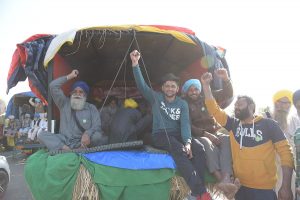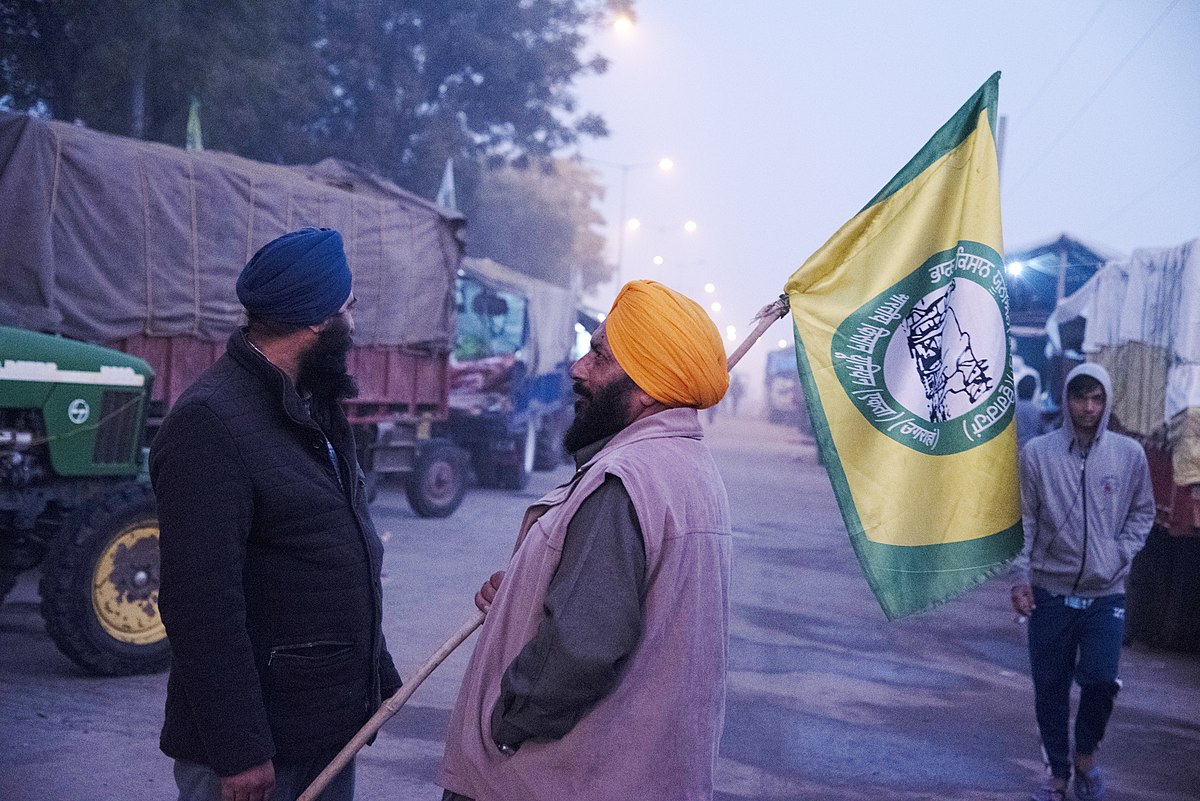[vc_row][vc_column][vc_column_text]

Farmers protesting/Randeep Maddoke/WikiCommons
India is currently witnessing one of its longest and largest ever expressions of dissent. Farmers – protesting three laws passed in September by the central government – have been camping at the borders of the national capital since 26 November last year, challenging the powers in New Delhi.
The protests would seem, on the surface, to show that India is functioning as a democracy with the freedom of individuals to protest. It is therefore ironic that at least seven journalists have been booked for reporting on the events that have transpired during the clashes between police and authorities.
On 29 January , six prominent journalists – Rajdeep Sardesai, Mrinal Pande, Zafar Agha, Vinod Jose, Paresh Nath and Anant Nath – were booked by Uttar Pradesh and Madhya Pradesh police under charges of sedition, criminal conspiracy and promoting enmity.
A day later, freelance journalist Mandeep Punia, who was on a project for The Caravan magazine, was detained by the Delhi police, a few hours after he went live on Facebook and reported on how stones were pelted at the farmers at Singhu border, even as security personnel looked on. He has since been granted bail.
Based on eyewitness testimony during a rally by the protesting farmers on Republic Day, 26 January, when India celebrates the 1950 entry into force of its Constitution, The Caravan reported that a man was killed after being shot by the Delhi police. Sardesai, Pande and Agha’s tweets echoed the testimony.
Police have vehemently denied shooting the farmer, which they claim is backed up by an autopsy report. However, the man’s family has refused to accept the Delhi police’s claim. “The doctor even told me that even though he had seen the bullet injury, he can do nothing as his hands are tied,” the farmer’s grandfather told Indian news website The Wire.
Siddharth Varadarajan, founding editor of The Wire, was booked by the Uttar Pradesh police for tweeting the police report of the incident.
While the controversy around the farmer’s death is far from settled, the government’s decision to go after these journalists is only the latest episode of its effort to gag the voices that have dared to question it.
The question arises, why would the central government of the largest democracy in the world choose to take these steps? This was answered by the secretary general of the Press Club of India during a meeting organised to protest the intimidation of journalists covering the protests.
“The government is sending a message that while on paper we’re a democracy, we are behaving like several undemocratic states of the world,” Anand Kumar Sahay said.
The statement encompasses almost everything that journalists in India, who are not toeing the line yet, deal with as they try to speak truth to powerful authorities. India lies 142nd on Reporters Without Borders’ world press freedom rankings.
RSF says: “Ever since the general elections in the spring of 2019, won overwhelmingly by Prime Minister Narendra Modi’s Bharatiya Janata Party, pressure on the media to toe the Hindu nationalist government’s line has increased.”
That a large number of journalists are being booked, arrested or assaulted for doing their job just around these farmers’ protest tells a worrying story. A more thorough examination of the cases, with focus on the organisations that these journalists represent and the ideology that they support, will show whether Modi is targeting just the critical media or journalism as a whole.
There are also more covert ways in which the far-right party that governs the Indian state has told news establishments to not speak out against them if they want to preserve their business.
The mainstream news organisations in the country typically function on an advertisement-based revenue model. While this has helped in keeping the cost of the national dailies low, it has also made them dependent on large corporations and the government, the two biggest advertisers in newspapers.
As expected, the government has not missed the opportunity to milk this dependency and has led many media organisations to indulge in self-censorship and push the government agenda forward, particularly during the Covid pandemic when government advertising has increased.
While there is ample evidence of censorship by the Indian government on independent news websites like Newslaundry, it was also hinted at by the Modi in an interview with prominent English daily The Indian Express, in the run-up to Assembly Elections 2019.
In the article, Modi talks about the PM-KISAN income support or ‘dole’ scheme for farmers and compares this with payments received by other sectors from the government, such as publishing.
“I give advertisements to the Indian Express. It doesn’t benefit me, but is it a dole? Advertisements to newspapers may fit into a description of dole,” Modi said.
Media organisations are therefore on a warning by the government.
The close government scrutiny had also become clear back in 2018, when anchor Punya Prasun Bajpai was forced out from ABP News.
In a detailed account of the reasons behind his departure, Bajpai described how the channel’s proprietor had told him to avoid mentioning Modi’s name in the context of any criticism of the government.
Bajpai also described a 200-member monitoring team that was involved in observing news channels resulting in directives that would be sent to editors about what should be showed and how.
These “commandments”, which were reserved for TV news and large national dailies until 2019, have now reached the digital versions of these conventional news organisations. The only journalistic outfits who have dared to critically examine this government’s rule operate as digital platforms. The government is thus looking to “regulate” their work as well.
Censorship of content that is consumed by millions has not existed before on this scale.
But it has now permeated the Indian media to such an extent that freshers starting work in media are being told to “ride the tide” and “reserve their optimism” for when the political environment is less volatile.
[/vc_column_text][/vc_column][/vc_row][vc_row][vc_column][three_column_post title=”You may also like to read” category_id=”5656″][/vc_column][/vc_row]





